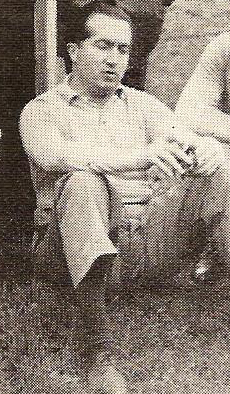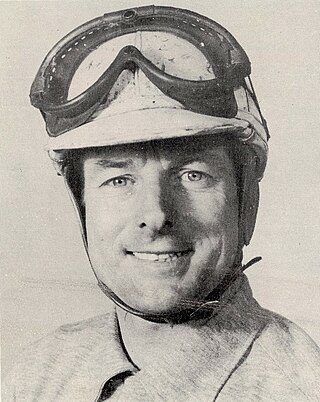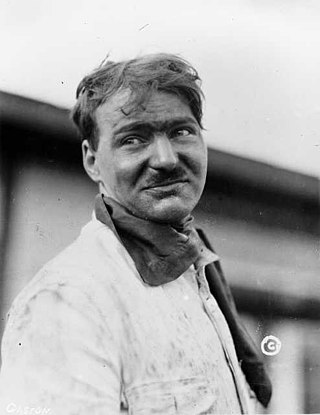Related Research Articles

Ray Wade Harroun was an American racing driver and pioneering race car constructor. He is most famous for winning the inaugural Indianapolis 500 in 1911.

The 1952 Formula One season was the sixth season of FIA Formula One motor racing. It featured the 3rd World Championship of Drivers, which was contested over eight races between 18 May and 7 September 1952. The season also included several non-championship races and a separate East German Championship.

Troy Lynn Ruttman was an American racing driver. He is best known for winning the 1952 Indianapolis 500 - at the age of 22 years and 80 days, Ruttman remains the youngest ever winner of the event. Competing since the age of 15, he had a remarkably successful early career, winning several regional and AAA-sanctioned championships.

Samuel Dwight Hanks was an American racing driver who won the 1957 Indianapolis 500. He was a barnstormer, and raced midget and Championship cars.

Gaston Louis Chevrolet was an American racing driver and automobile manufacturer. He was the winner of both the Indianapolis 500 and the American National Championship in 1920.
The 1919 Grand Prix season was the first season following the armistice that ended World War I in November 1918. European economies were struggling, and many automotive firms had to recover and retool from military production. So, there was very little racing activity as it took time for the companies and populations to recover. As the world rebuilt there were only two major races held in the year – the Indianapolis 500 and the Targa Florio.
The 1905 AAA National Motor Car Championship consisted of 11 points-paying races, beginning in The Bronx, New York on June 10 and concluding in Poughkeepsie, New York on September 29. There were also at least two non-championship events held during the year. This was the first year that the AAA Contest Board officially recognized a National Champion in American Championship Car competition.
The 1909 AAA Championship Car season consisted of 24 races, beginning in Portland, Oregon on June 12 and concluding with a point-to-point race from Los Angeles, California to Phoenix, Arizona on November 6. There were three events sanctioned by the Automobile Club of America in Lowell, Massachusetts. AAA did not award points towards a National Championship during the 1909 season, and did not declare a National Champion.
The 1910 AAA Championship Car season consisted of 19 races, beginning in Atlanta, Georgia on May 5 and concluding in Long Island, New York on October 1. AAA did not award points towards a National Championship during the 1910 season, and did not declare a National Champion.

The 1911 AAA Championship Car season consisted of 21 races, beginning in Oakland, California on February 22 and concluding in Savannah, Georgia on November 30. AAA did not award points towards a National Championship during the 1911 season, and did not declare a National Champion. Ray Harroun was the winner of the inaugural Indianapolis 500.
The AAA Contest Board was the motorsports arm of the American Automobile Association. The contest board sanctioned automobile races from 1904 until 1955, establishing American Championship car racing. Modern-day Indy car racing traces its roots directly to these AAA events.
The 1920 AAA Championship Car season consisted of 5 races, beginning in Beverly Hills, California on February 28 and concluding in Beverly Hills on November 25. The AAA National Champion and Indianapolis 500 champion was Gaston Chevrolet. The 1920 season later became a source of confusion and misinformation for historians when in 1926 the AAA published a revisionist history, naming another driver as the season's point champion.
The 1946 AAA Championship Car season was the first season of American Championship car racing following World War II. After four years without automobile racing in the United States, the AAA Contest Board was initially concerned about having enough races, enough entrants, and suitable equipment, to contest season on such short notice for 1946. Even the Indianapolis 500 was in doubt, as the Indianapolis Motor Speedway had been fallen into a terrible state of neglect during the war years.
The 1912 AAA Championship Car season consisted of 18 races, beginning in Santa Monica, California on May 4 and concluding in Brooklyn, New York on November 5. There was also one non-championship event at Milwaukee, Wisconsin. AAA did not award points towards a National Championship during the 1912 season, and did not declare a National Champion. Joe Dawson was the winner of the Indianapolis 500.
The 1913 AAA Championship Car season consisted of 14 races, beginning in San Diego, California on January 1 and concluding in Corona, California on September 9. AAA did not award points towards a National Championship during the 1913 season, and did not declare a National Champion. Jules Goux was the winner of the Indianapolis 500.
The 1914 AAA Championship Car season consisted of 15 races, beginning in Santa Monica, California on February 26 and concluding in Corona, California on November 26. AAA did not award points towards a National Championship during the 1914 season, and did not declare a National Champion. René Thomas was the winner of the Indianapolis 500.
The 1915 AAA Championship Car season consisted of 27 races, beginning in San Diego, California on January 9 and concluding in San Francisco, California on November 25. AAA did not award points towards a National Championship during the 1915 season, and did not declare a National Champion. Ralph DePalma was the winner of the Indianapolis 500.

The 1917 AAA Championship Car season consisted of 21 races, beginning in Los Angeles, California on March 4 and concluding there on November 29. AAA did not award points towards a National Championship during the 1917 season, and did not declare a National Champion.
The 1919 AAA Championship Car season consisted of 21 races, beginning in Santa Monica, California on March 15 and concluding in Cincinnati, Ohio on October 12. AAA did not award points towards a National Championship during the 1919 season, and did not declare a National Champion. Howdy Wilcox was the winner of the Indianapolis 500.
References
- ↑ Capps, H. Donald (February–March 2010). "John Glenn Printz and the Struggle for the Past: The A.A.A. Catastrophe - Arthur Means, Val Haresnape, Russ Catlin, and Bob Russo" (PDF). Rear View Mirror. 7 (6): 21–38.
- http://www.champcarstats.com/year/1918.htm accessed 12/1/15
- http://www.teamdan.com/archive/gen/indycar/1918.html accessed 12/1/15